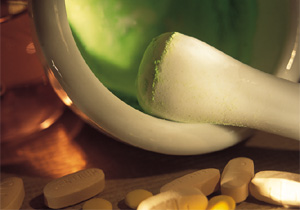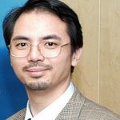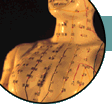|
 |
Introduction to TCM

Basics of TCM

• Yin-Yang | Five Elements

Zang-Fu Theories

• Zang Organs | Fu Organs

Classification of Antineoplastic Herbal Medicines

Characteristics of Herbal Medicines

Diagnose

• By Auscultation & Olfaction
• By Inspection

Prescriptions

Theories of Channels (Meridians) and Collaterals

Reference: A Modern View of the Immune System

Differentiation of Syndromes

• 8 Principles
• 6 Channels 4 Stages
• Syndromes of Zang-Fu Organs

Etiology

• Exogenous
| Pestilential
• Pathogenic Factors
• Emotional

Materia Medica


Back to Home

|
 |

The Application of Yin-Yang Theory to the Field of Traditional Chinese Medicine
The theory of yin and yang is used extensively in traditional Chinese
medicine to explain the histological structure, physiological function,
and pathological changes of the human body, and to serve as guide for
diagnosis of treatment.
The Anatomical and Histological Structure of the Human Body
The Yin-Yang theory asserts that the human body is an organic whole,
and there exists an organic connection between all tissues and structures.
Yet, at the same time, each of them can be divided into the opposite aspects of yin and yang.
Viewing the body as a whole, the portion above the waist pertains to yang
and that below belongs to yin; the exterior of the body is associated with yang,
while the interior is associated with yin; the back is considered yang and the
front, yin; the lateral aspect is yang and the medial, yin.
The zang-fu organs also have yin and yang aspects, the six fu organs
are considered yang while the zang organs are yin. Each of the zang-fu organs
itself can again be divided into yin or yang; for example, heart yin and heart
yang or kidney yin and kidney yang. However complex, all human body
structures and tissues can be generalized and explained by the yin-yang
relationship. As the Suwen says, "Man has physical shape which is inseparable
from yin and yang."
The Physiological Functions of the Human Body
The Yin-Yang theory considers the normal vital activities of the human body
to be the result of the relative balance between yin and yang. In traditional Chinese
medicine, the physiological functions of the organs and their substances are
inseparably related to yin and yang. For example, the activities (yang) of a
particular organ are based on that organ's substance (yin) and when either of
these aspects is absent, the other cannot function. Thus the result of physiological
activities is to constantly promote the transformation of yang into yin essence. If yin and
yang cannot maintain relative balance and interaction, they will separate
from each other ending the life that depends upon them. As the Suwen says,
"When yin keeps balance with yang and both maintain a normal condition of qi,
then health will be high-spirited. A separation of yin and yang will lead to
the exhaustion of essential qi."
The Pathological Changes of the Human Body
The Yin-Yang theory holds that disease is a result of an imbalance between
yin and yang which leads to the hyperactivity or hypoactivity of yin and yang.
The occurrence and the development of a disease are also related to zheng qi
(body resistance or antipathogenic factors) and xie qi (pathogenic factors).
The Yin-Yang theory can be used to generalize the interacting relations between
body resistance and antipathogenic factors. Pathogenic factors are divided into
yang-natured pathogenic factors and yin-natured pathogenic factors, while zheng
qi includes yin essence and yang qi. Yang pathogenic factors may bring about
hypoactivity of bodily yang which leads to injury of yin; a heat syndrome results.
If the disease is caused by yin pathogenic factors, it may give rise to hypoactivity
of yin followed by the injury of yang; a cold syndrome will result. When yang
is deficient it fails to restrict yin in the balanced relationship between the two
giving rise to xu (deficiency) which is a cold syndrome. The xu heat symptoms
complex, however, is caused by a yin deficiency and yang excess. Pathological
changes of disease are varied, but can be generally explained in terms of
yin-yang imbalance: yin excess causes cold syndromes, yang preponderance
leads to heat syndromes, yang deficiency causes cold syndromes, and yin
deficiency leads to heat syndromes.
Diagnosis of Diseases
The basic causative factor of disease is an imbalance between yin and yang.
Therefore, no matter how intricate and volatile the clinical manifestations are,
they can still be summarized into two categories: yin syndromes and
yang syndromes. A correct diagnosis depends upon a clear classification of
yin and yang syndromes or in the words of the Suwen, "If one is good at
diagnosis, they should differentiate the yin from yang after the observation
of color (of complexion, tongue, urine, stool, etc.) and feeling the pulse."
The four diagnostic methods (inspection, auscultation and olfaction, inquiry,
and palpation) also use yin and yang, for example: interior, xu (deficiency),
and cold syndromes are considered yin; exterior, shi(excess), and heat
syndromes are considered yang; bright color is yang, dim color is yin; a
sonorous voice indicates yang, a low voice is yin; feeble and weak respiration
is yin, coarse breathing is yang; superficial, rapid, and forceful pulses are
yang, slow, deep feeble, and weak pulses are yin.
Applications in Clinical Treatment
Since imbalance and fluctuation of yin and yang are considered the
basic causative factors of disease occurrence and development, treatment
must readjust yin and yang to their basic state of relative balance. For
example, if pathogenic heat, a yang disease causative factor, is
overabundant, it consumes the yin fluid and affects the superabundant
yang of the body. In this case, the cold methods for heat syndromes
(for example, the use of herbs with a "cold" nature to cure "heat" illnesses)
is the prescribed treatment. If pathogenic cold is in excess, it will
damage the yang qi and exert influence on the body's remaining yin.
In this case, the heat method for cold syndromes (for example, the
use of herbs with a "hot" nature to cure "cold" illnesses) is sued.
Conversely, in cases where yang excess if caused by insufficient yin
fluid failing to restrict yang or where yin preponderance is due to yang
qi deficiency being unable to control yin, then treatment should
reinforce the insufficient yin or yang. The general principle is, "Treat
yin for yang diseases, and treat yang for yin disorders."
In medical treatment, the theory of yin and yang is not only used to
decide the principles of treatment. This theory is also generally applied
to the properties, flavor and action of Chinese herbal medicine as a
guide to the clinical administration of herbs. For example, drugs
with cold, cool or moist properties are classified as yin and
drugs with the opposite properties are classified as yang. Herbs
with sour, bitter, or salty flavors are yin, while those with pungent,
sweet, or insipid flavors are yang. Drugs with an astringent or descending
action are yin and those with an ascending and dispersing action are yang.
In clinical treatment, we should determine the principles of treatment based
on an analysis of the yin and yang conditions present in terms of their
difference yin-yang properties and actions. The goal of clinical treatment
is to restore of healthy yin-yang properties and actions. The goal of
clinical treatment is to restore a healthy yin-yang balance in the patient.
|

|
|
|
|
|
 |

|
WHAT IS TRADITIONAL CHINESE MEDICINE?

Photo © Image DJ Image Dictionary
With over 3000 years of experience, Traditional Chinese Medicine (TCM) has
remain one of the many fascinating areas in ancient Chinese culture.
First known to be documented in the Yellow Emperor's Canon of Medicine,
TCM is believed to have been practised in as early as 475 to 221 B.C.
The field of working knowledge of TCM stretches from anything related to
general healthcare practice to the philosophy of the mind, the logic of life,
religion, and even to as far as cosmology and astronumerology. This is why
in order to thoroughly understand the concepts behind TCM, one must be
comprehensive in learning and embracing the Chinese culture as a whole.
Just as Douglas Hoff put it when he explained about accupuncture, "The systems
of TCM uses the concepts of elements and meridians and are completely immersed
in the Asian cosmology which takes shape through the religions." The meridian-brain mechanism,
the fundamental working concept of acupuncture, in which the pain block from the message
that the needle or burning cone of herbs gives to the point of stimulus,
was only found centuries later by the West through science and technology.
|
| |
|
MESSAGE FROM THE EDITOR – MARCH 2020
 Thank you for visiting this TCM and acupuncture information website.
If you have previously been to this website, you might have
noticed that some of the pages on ancient historical ideas and
holistic thinkings related to Chinese metaphysics are temporarily taken offline.
This is because I will be revamping the whole website and be moving
those information into a new \"Ancient Chinese Culture\" section
so as to reflect a more current perspective on the interpretation
of some of the fundamental concepts as well as to include
some of the latest information in the area.
But if you have just found this website for the very first time, I welcome you again and
wish you could find what you require and, hopefully, you could also be benefitted
from reading the articles I published on this website.
Thank you for visiting this TCM and acupuncture information website.
If you have previously been to this website, you might have
noticed that some of the pages on ancient historical ideas and
holistic thinkings related to Chinese metaphysics are temporarily taken offline.
This is because I will be revamping the whole website and be moving
those information into a new \"Ancient Chinese Culture\" section
so as to reflect a more current perspective on the interpretation
of some of the fundamental concepts as well as to include
some of the latest information in the area.
But if you have just found this website for the very first time, I welcome you again and
wish you could find what you require and, hopefully, you could also be benefitted
from reading the articles I published on this website.
Please be patient and do come and check out this website frequently as it's being revamped.
Raymond Cheng, PhD DPA FRSA FRSPH

March 28, 2020.
|

|
IMPORTANT NOTICE AND DISCLAIMER

 This website is published, edited and designed by Raymond Cheng,
and reflects only and only his personal views and opinions in his individual capacity.
The information available at this website is not intended
directly or by implication to either diagnose or treat any
medical, emotional, or psychological condition or disorder.
It is also not intended to create a physician-patient relationship
between you and I or between you and Wyith Institute™ and The Office of Dr Raymond K K Cheng.
The information here is not a substitute for advice and treatment provided
by your physician or by another healthcare professional.
It is always recommended that consultation with local healthcare providers
be obtained for any of your specific health or medical concerns.
Furthermore, any products that can be purchased (yet you can see I don't have much
to sell here) through advertisers' banners or through links to other websites
are not either explicitly or implicitly given any warranty or endorsement
by me, my colleagues, Wyith Institute™ or any of its associated businesses.
This website is published, edited and designed by Raymond Cheng,
and reflects only and only his personal views and opinions in his individual capacity.
The information available at this website is not intended
directly or by implication to either diagnose or treat any
medical, emotional, or psychological condition or disorder.
It is also not intended to create a physician-patient relationship
between you and I or between you and Wyith Institute™ and The Office of Dr Raymond K K Cheng.
The information here is not a substitute for advice and treatment provided
by your physician or by another healthcare professional.
It is always recommended that consultation with local healthcare providers
be obtained for any of your specific health or medical concerns.
Furthermore, any products that can be purchased (yet you can see I don't have much
to sell here) through advertisers' banners or through links to other websites
are not either explicitly or implicitly given any warranty or endorsement
by me, my colleagues, Wyith Institute™ or any of its associated businesses.
|

|
|

 This website is published, edited and designed by Raymond Cheng,
and reflects only and only his personal views and opinions in his individual capacity.
The information available at this website is not intended
directly or by implication to either diagnose or treat any
medical, emotional, or psychological condition or disorder.
It is also not intended to create a physician-patient relationship
between you and I or between you and Wyith Institute™ and The Office of Dr Raymond K K Cheng.
The information here is not a substitute for advice and treatment provided
by your physician or by another healthcare professional.
It is always recommended that consultation with local healthcare providers
be obtained for any of your specific health or medical concerns.
Furthermore, any products that can be purchased (yet you can see I don't have much
to sell here) through advertisers' banners or through links to other websites
are not either explicitly or implicitly given any warranty or endorsement
by me, my colleagues, Wyith Institute™ or any of its associated businesses.
This website is published, edited and designed by Raymond Cheng,
and reflects only and only his personal views and opinions in his individual capacity.
The information available at this website is not intended
directly or by implication to either diagnose or treat any
medical, emotional, or psychological condition or disorder.
It is also not intended to create a physician-patient relationship
between you and I or between you and Wyith Institute™ and The Office of Dr Raymond K K Cheng.
The information here is not a substitute for advice and treatment provided
by your physician or by another healthcare professional.
It is always recommended that consultation with local healthcare providers
be obtained for any of your specific health or medical concerns.
Furthermore, any products that can be purchased (yet you can see I don't have much
to sell here) through advertisers' banners or through links to other websites
are not either explicitly or implicitly given any warranty or endorsement
by me, my colleagues, Wyith Institute™ or any of its associated businesses.



 Thank you for visiting this TCM and acupuncture information website.
If you have previously been to this website, you might have
noticed that some of the pages on ancient historical ideas and
holistic thinkings related to Chinese metaphysics are temporarily taken offline.
This is because I will be revamping the whole website and be moving
those information into a new \"Ancient Chinese Culture\" section
so as to reflect a more current perspective on the interpretation
of some of the fundamental concepts as well as to include
some of the latest information in the area.
But if you have just found this website for the very first time, I welcome you again and
wish you could find what you require and, hopefully, you could also be benefitted
from reading the articles I published on this website.
Thank you for visiting this TCM and acupuncture information website.
If you have previously been to this website, you might have
noticed that some of the pages on ancient historical ideas and
holistic thinkings related to Chinese metaphysics are temporarily taken offline.
This is because I will be revamping the whole website and be moving
those information into a new \"Ancient Chinese Culture\" section
so as to reflect a more current perspective on the interpretation
of some of the fundamental concepts as well as to include
some of the latest information in the area.
But if you have just found this website for the very first time, I welcome you again and
wish you could find what you require and, hopefully, you could also be benefitted
from reading the articles I published on this website.